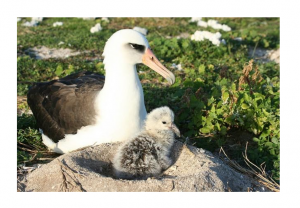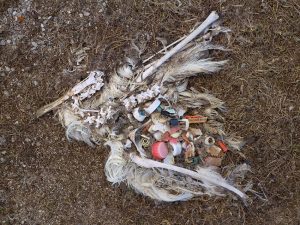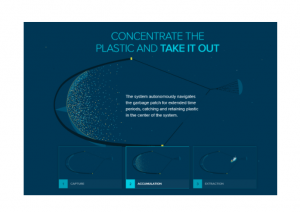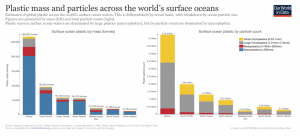14
Aidan Bryar, Anna Cox, Nathalie Martin-Nucatola, and Patrick McKenna
Abstract
Around one million seabirds are affected each year by the plastic in the Great Pacific Garbage Patch; especially the Laysan Albatross due to their close proximity. The Laysan Albatross enriches the nutrients of the soil improving the island ecosystem. This bird is at a higher risk for plastic consumption and is already on the near-threatened list. We examined different conservation techniques to determine the best method. These range from juvenile relocation, ocean current examination, river clean-up, and even a surgical attempt. This chapter argues the importance of cleaning rivers as the best approach to preserve the Laysan Albatross.

A Deep Dive into the Great Pacific Garbage Patch
The Great Pacific Garbage Patch, a swirling vortex of trash that spans from Hawaii to Japan, is getting larger by the day. The Great Pacific Garbage Patch is approximately 1.6 million square kilometers, and for context, that is twice the size of Texas and three times the size of France. Why is this garbage patch so large? Part of the problem is that plastic items do not break down in a timely manner. For example, plastic bottles, an extremely common household object, can take up to 450 years to decompose. Some other plastic items, such as plastic bags, another common-use item, can take up to 1,000 years to break down. Needless to say, plastic is not going away on its own, and oftentimes it finds its way into the ocean to be picked up by currents that then deposit the plastic in the swirling gyres that make up the Great Pacific Garbage Patch (Lowe, 2019). What exactly is the Great Pacific Garbage Patch? Garbage patches are formed when gyres, which are rotating ocean currents, pick up trash and gather the trash to a central location. This does not form an “island” of trash like many would assume when they imagine a garbage patch. The debris instead is found from the surface of the ocean, all the way to the ocean floor (Marine Debris Program, 2020).
The Great Pacific Garbage Patch has deep effects on the environment. Especially on marine life. One such effect is ghost fishing, where abandoned fishing equipment continues to catch animals and then causes serious damage and even death. Another effect is the transportation of invasive species. The debris can transport barnacles and crabs and transport them to another area and hinder the native species in that new area. One effect of the Great Pacific Garbage Patch that can cause serious damage to seabirds is the act of ingestion. Many seabirds fly over the Pacific Ocean to gather food for themselves, and their chicks. The Laysan Albatross, a bird that resides on the Midway Atoll, found in the middle of the Great Pacific Garbage Patch, is one such victim of ingestion. The Albatross mistakes the brightly colored pieces of plastic as food and ingests them without realizing that what they are eating is not, in fact, food. This can lead to starvation, blockage, and even death (Jones, 2019).
As previously stated, the Great Pacific Garbage Patch is growing every day. Each year, about 1.15 to 2.41 million tonnes of trash enter the ocean. By 2050, in just 30 short years, it is estimated that there will be more trash in the ocean than fish. It is also estimated that by 2050 99% of all seabirds will have ingested plastic. Trash does not just affect the animals of the ocean, it also affects humans. Microplastics have been found in sea salt, shellfish, and even 94% of tap water (Lowe, 2019). It has even been found in beer and honey. Currently, researchers do not know how these microplastics will affect humans in the long run but it is definitely not beneficial in any way. The trash can also be a real hazard to marine vessels. Nets can become wrapped up in propellers and trash can hit the actual vessel causing damage. Needless to say, the Great Pacific Garbage Patch is a serious environmental issue that not only affects marine life, but also navigation, marine vessels, and even the economy (Marine Debris Program, 2020).

The Bird-un of the Albatross

The Laysan Albatross (Phoebastria immutabilis) faces minimal natural obstacles; however, some of their biggest problems originate from human invention. As of 2018, the Laysan Albatross is considered near threatened by the IUCN Red List (BirdLife International, 2018). Some of their biggest threats of survival come from “fisheries bycatch, predation by alien species at nesting colonies, bioaccumulation of contaminants, and ingestion of plastic” (VanderWerf & Young, 2011). In this chapter, we will be examining the direct threat that plastic consumption has on the Laysan Albatross population.

The largest breeding colony of the Laysan Albatross resides on the Midway Atoll, which is part of the Northwestern Hawaiian Islands (BirdLife International, 2018). They are long-lived seabirds, with a lifespan of 60 years, nearly 20 times longer than the average bird’s (Bakermans, M., personal communication, 2020). However, their population is at risk as plastic pollution becomes an increasing issue. Their diet consists mostly of crustaceans, cephalopods, and fish (Petry et al., 2007), and often, they mistake plastic of similar size, color, and shape as their prey (Pierce et al., 2004). For example, the well-known red coca-cola bottle cap resembles closely to a squid, and so it is consumed without a second thought (CNN, 2016). The ingested plastic is then transferred to fledglings through regurgitation. Regurgitation is the action of casting up incompletely digested food, and the way in which birds feed their young (Merriam-Webster, n.d.). A study has shown that the ingestion of plastic is harmful to the weight gain and survival of Laysan chicks, which is detrimental to their population growth (Lavers & Bond, 2016). Laysan Albatross only produce one egg per clutch, and so the survival of the egg is of the utmost importance (Marine Debris Program, 2020).
The Laysan Albatross catch their food by plunging their necks under the surface of the water. This technique provides many chances for them to pick up plastic in accidental bycatch as well. While plastic can not fully disintegrate, it does break down into smaller and smaller pieces, called microplastics and nanoplastics (CNN, 2016). These small particles release their toxins into the ocean, while also attracting other chemicals such as pesticides to them. Not only can marine life consume these plastics, but nanoplastics are so small that they can pass through tissue membranes, furthering the spread of plastic consumption. A study has shown that “high levels of ingested plastic were correlated with increased concentrations of chlorine, iron, lead, manganese, and rubidium in feathers” (Lavers & Bond, 2016). These high chemical concentrations in the Laysan Albatross can “indirectly contribute to [their] mortality or morbidity” and lower reproduction success.
We talked with Mark Pokras, a professor at Tufts Cummings School of Veterinary Medicine, who said that plastic consumption has not always been as big of a problem as it has become. Oftentimes, the Albatross can either eliminate the small plastic particles or regurgitate them back up. It is when the plastic gets lodged in an important pathway that the bird can die of starvation, dehydration, or a corrupt digestive system (Pierce et al., 2004). As plastic consumption and pollution grow, the Laysan Albatross population continues to be at risk.
Quacking the Case: Prevention and Conservation Methods
The Laysan Albatross has many programs that look out for their well-being, such as Papahanaumokuakea Marine National Monument’s prohibition of longline fishing, or eradication efforts of introduced invasive species (Awkerman et al., 2020, Kaiser, 2017). However, these programs do not combat the issue of plastic pollution and consumption, and with the increase of plastic production due to the Covid-19 pandemic, an addendum to these methods that focuses on the issue of plastic pollution is greatly needed. There are multiple ways in which plastic pollution can be combated. Some methods include the relocation of the juvenile Laysan population, cleaning up plastic before it enters the oceans, i.e. from the rivers, researching the Great Pacific Garbage Patch gyres and currents, or surgical removal of plastic.
Juvenile Relocation
Juvenile Relocation looks to be one of the most promising ways to help these birds, yet this is not quite the case. We reached out to Mark Pokras to ask him if this would in fact be a viable solution, to which he replied with a concern about the Albatross feeding flight and the locations the Albatross feed from. After all, almost all seabirds are eating plastic coming from the ocean and as plastic production inevitably increases location will not be as big of a factor. Even if efforts were made to relocate the Laysan Albatross it would be costly and take up a lot of time. It would also be hard to find an island that would meet the requirements they need to survive when they are young. They need a lack of natural predators like rats who would eat their eggs, as they build their nests upon the ground (Kaiser, 2017). The Albatross can fly up to 500 miles in a single day staying in the air for much of that time (Chu, 2017). During their flights, it is likely that an Albatross picks up plastic and feeds it to their young or keeps it for themselves. We have come to the conclusion that the rate at which these birds are consuming plastic in a relocated area vs their original habitat is not sufficient enough for a prevention method.
Cleaning the Rivers

Plastic consumption is continuously growing and is not going to stop anytime soon. It reached just over 320 million metric tons in 2018 (Lebreton et al., 2018). With a number this large, it is inevitable that at least a fragment of the trash will end up in the ocean. Once in the ocean, different gyres pick up the trash and a considerable amount finds its way to the Great Pacific Great Patch. An example of one of these gyres is the Kuroshio Extension. This gyre takes a large amount of plastic from Asia and feeds it into the Pacific where it eventually reaches the Great Pacific Garbage Patch (Lebreton et al., 2018). Studies have shown that one thousand rivers contribute to 80% of ocean plastic pollution (The Ocean Cleanup, 2020). Some rivers contribute more to the Great Pacific Garbage Patch than others due to their location. The Ocean Cleanup has discovered a way to prevent the trash from reaching the ocean. CEO Boyan Slat has stated that they created a device known as the Interceptor that will patrol the rivers and catch trash before it leaves (Kavanaugh, 2019). The device has promise, but there are more than 1,000 rivers that contribute to the Great Pacific Garbage Patch (Kavanaugh, 2019). It is not very realistic for this nonprofit organization to make this many Interceptors without a substantial amount of funding. By funding any type of cleanup or any projects with the Great Pacific Garbage Patch, governments would be admitting that they are accountable for it and the cost of cleaning it would bankrupt any country. This is one reason why implanting the Interceptor could prove to be troublesome. Another is that these Interceptors would be all over the globe and convincing each country that is responsible to take part in this cause is also very unrealistic. However, compared to other options, this is the most cost-effective and helpful.
Ocean Currents

The reason the Great Pacific Garbage Patch is an actual occurrence is because of the gyres that gather pollution from all across the ocean and collect it. The gyres themselves are caused by large-scale wind patterns and thermohaline circulation. Thermohaline circulation is caused by differences in the density of the water in relation to the temperature of the water and the salinity (Sundermeyer, M., personal communication, 2020). Now the question is, can we somehow use currents in the ocean to prevent Albatross from consuming plastic? Potentially there is a solution that utilizes natural forces such as ocean currents and wind patterns currently in development. The Ocean Cleanup, one of the main combatants of the Great Pacific Garbage Patch, has developed System 001/B. This invention utilizes a floater system at the top and then a long hanging net/skirt to catch any debris that may reside just below the surface of the water. In its year-long trial period in 2019, it minimally interfered with marine life and measures have been taken to ensure no marine vessels would come close to System 001/B (The Ocean Cleanup, 2020). System 001/B has proven that understanding the currents of the ocean could be the next big step in cleaning up the pollution of the Great Pacific Garbage Patch. The Ocean Cleanup’s research even shows that if large-scale use of this system was put into place, 50% of the pollution in the ocean could be removed in just 5 years (The Ocean Cleanup, 2020).
While this invention has a lot of upsides to it, in terms of the Albatross this might not be overly helpful in preventing them from mistaking the plastic for food. System 001/B collects the debris in the nets but Albatross and other seabirds could still see brightly colored plastic within the net, and mistake it for food. System 001/B’s focus is to collect the pollution and keep it there until it reaches a certain accumulation point for workers to then empty the nets (The Ocean Cleanup, 2020). There is nothing stopping the Albatross from swooping in to eat the trash. So while this invention is extremely helpful in the long run in reducing the size of the Great Garbage Patch, it is not necessarily helpful in preventing the immediate threat to the Albatross. However, the Ocean Cleanup might make alterations to their System 001/B in the next version, which should be debuted in 2021, that may prevent wildlife like the Albatross from accessing the plastic.
Surgery… Fatal or Lifesaving?
As severe as it may seem, surgery is an option for removing the trash from birds. It is considered rare and does not happen that often. Mark Pokras said that it starts with x rays of the birds being taken, as well as an endoscope, and if trash is found, then the people examining the bird will try to get the said bird to regurgitate. If this fails and the trash found inside the bird will eventually kill it, then surgery is considered. The surgery method provides an abundance of problems. Many of these birds are too weak to undergo the anesthesia and will die during the surgery, x rays do not show everything inside of the bird so there could be surprises once the bird is open, and it is not realistic for this to be a go-to option for every bird. There are too many birds that have trash in their organs for this to be considered as a solution. The amount of money it would take to fund an experiment like this is far too great and the odds of success are very low. This being said, every now and then surgery can be a viable option for a select few birds that are deemed strong enough to survive and if there are no other ways.
Munching on Microplastics
Plastic is a huge problem in the Great Pacific Garbage Patch because the buildup contributes to the gyres that make up the patch. The microplastic waste sits on the ocean surface, invisible to the human eye, providing a shield to the other trash. Microplastics are also a huge danger to the Albatross who ingest microplastics and even macroplastics unknowingly which causes harm to their bodies over time. Only 0.2% of Shearwater birds were found to have not ingested plastic according to expert Mark Porkras who conducted a field study on plastic found in dead Shearwater birds. This concern is only growing as the Garbage Patch grows near the Albatross’ habitat. Even if these birds were relocated, they would still consume plastic during their feeding flight which aligns with the Great Pacific Garbage Patch. Microplastics are small, almost invisible plastic particles that can rest inside living beings as well as the ocean and everything else we know. Macroplastics are more visible conventional plastic waste that we see more commonly. Microplastics are just the near-end result of the decay of Macroplastics which go through a life cycle of their own (Lucas, 2018). Looking more in-depth into the chemical makeup of plastics in general we may have a hard time finding a solution even among professionals who are still researching microplastics as a relatively new concept (Liittschwager, 2020). Emerging studies on bio-plastics that break down over time could be the key to future environmental health.
We have looked at methods such as taking trash from the source; rivers, streams, and lakes. This is ideal because most plastic pollution starts in these areas and feeds into the larger bodies of water. We have also looked into the production aspect of plastic which plays a big role in today’s society especially because of covid-19. Mask production has severely impacted the albatross species as professionals advise people to cut their mask straps after use to save the birds from death by suffocation. With an increasing rate of plastic production, there is a greater need for ecologically friendly solutions related to plastics for our daily use.

Final Thoughts
The loss of the Laysan Albatross population would be harmful to the wellbeing of island wildlife and flora (Kaiser, 2017). Their impact on their surrounding ecosystem is often overlooked because of how little they directly affect human life. However, their contribution of nutrients to the island’s soil and habitats provides a healthy environment for all. With the ongoing pandemic, plastic usage and production have increased significantly due to sanitation concerns, and in turn, plastic pollution has increased (Silva et al., 2021). Therefore, the need for conservation methods, targeting the Laysan Albatross’ consumption of plastic, is in dire need of implantation and enforcement. After much research, we believe that the best conservation method is collecting plastic in rivers before it reaches the Great Pacific Garbage Patch and the Laysan Albatross population. We believe that this is a necessary step because it is hard to bail out a boat if the hole is not fixed. Investment and implantation of devices such as the Interceptor will hinder the amount of plastic entering the ocean. Additionally, the $777,000 cost of the Interceptor is a significant cost reduction compared to the +$30 billion needed to clean up the Great Pacific Garbage Patch (The Ocean Cleanup, 2020, Dautel, 2009).
While the solution we are proposing may seem too broad and does not directly combat the Albatross issue, we are taking into consideration that they are long-distance fliers which means just getting rid of plastic around their breeding colony will not stop their consumption. To truly help the Laysan Albatross, the growth of the Great Pacific Garbage Patch needs to be addressed. That means stopping the trash from reaching the ocean in the first place and controlling the flow of this process in the future is important. Overall, the Great Pacific Garbage patch is an extreme threat to the human population as well as the Laysan Albatross. The Laysan Albatross’ accidental consumption of microplastics is a continual issue, and while there are many potential solutions to this plastic threat, we have found that prevention is the best solution.
Flying Forward
In the future, governments are going to have to take accountability for the Great Pacific Garbage Patch. Allotting taxes or funds to invest in devices such as the Interceptor is the first step towards helping the Laysan Albatross. These devices have proven to be effective on the rivers in which they operate. In addition, we need to track the Laysan Albatross’ flight patterns to best determine areas in which they might feed. By doing this, we can focus on those areas of the Great Pacific Garbage Patch and use devices such as System 001/B most efficiently. We would also suggest further research in the production of bio-based plastics and how to implement them into the greater society. Bio-based plastics would be beneficial because if recycling efforts do not improve, plastics that fully break down once they reach the ocean will no longer not harm the Laysan Albatross.
Acknowledgments
We wanted to acknowledge and thank Professor Marja Bakermans, Mark Pokras, and Miles Sundermeyer for their contributions in their interviews. We would also like to thank Professor William San Martín and our PLA Sam Grillo.
References
Awkerman, J.A., Anderson, D.J., & Whittow, G.C. (2020). Laysan Albatross (Phoebastria immutabilis), version 1.0. In Birds of the World (A. F. Poole, Editor). Cornell Lab of Ornithology, Ithaca, NY, USA. https://doi.org/10.2173/bow.layalb.01
Bengali, S. (2020, June 14). The COVID-19 pandemic is unleashing a tidal wave of plastic waste. Los Angeles Times. https://www.latimes.com/world-nation/story/2020-06-13/coronavirus-pandemic-plastic-waste-recycling
BirdLife International. 2018. Phoebastria immutabilis. The IUCN Red List of Threatened Species 2018: e.T22698365A132643073. https://dx.doi.org/10.2305/IUCN.UK.2018-2.RLTS.T22698365A132643073.en.
Chu, J. (2017, October 10). Engineers identify key to albatross’ marathon flight. MIT News Office. https://news.mit.edu/2017/engineers-identify-key-albatross-marathon-flight-1011
CNN. (2016, November 30). Midway, a plastic island. [Video] YouTube. https://www.youtube.com/watch?v=lsJqMmuFWO4
Dautel, S.L. (2009). Transoceanic trash: International and united states strategies for the great pacific garbage patch. Golden Gate University Environmental Law Journal, 3(1), 181-208. https://digitalcommons.law.ggu.edu/gguelj/vol3/iss1/8/
Earth is Blue Magazine. (n.d.). Creature Feature Laysan Albatross. National Oceanic and Atmospheric Administration. https://sanctuaries.noaa.gov/magazine/4/laysan-albatross/
Jones, C. (2019, November 9). Pacific bird refuge struggles as ocean garbage patch grows. AP News. https://apnews.com/article/cbd7afa05cca4419aac876be291908cc
Kaiser, S. (2017, July 17). Seabirds: The ecological connectors in need of conservation. Island Conservation. https://www.islandconservation.org/seabirds-conservation-anthropocene/
Kavanaugh, C. (2019, October 28). ‘Interceptor’ aims to halt flow of plastic to oceans. Plastics News, 30(35). https://www.plasticsnews.com/news/interceptor-aims-capture-plastics-they-hit-oceans
Lavers, J.L, & Bond, A.L. (2016). Ingested plastic as a route for trace metals in Laysan Albatross (Phoebastria immutabilis) and Bonin Petrel (Pterodroma hypoleuca) from Midway Atoll. Marine Pollution Bulletin, 110(1), 493-500. https://doi.org/10.1016/j.marpolbul.2016.06.001
Lebreton, L., Slat, B., Ferrari, F., Sainte-Rose, B., Aitken, J., Marthouse, R., Hajbane, S., Cunsolo, S., Schwarz, A., Levivier, A., Noble, K., Debeljak, P., Maral, H., Schoeneich-Argent, R., Brambini, R., & Reiseer, J. (2018). Evidence that the great pacific garbage patch is rapidly accumulating plastic. Scientific Reports, 8(1), 4666–15. https://doi.org/10.1038/s41598-018-22939-w
Liittschwager, P.D. (2020, August 7). Microplastics have moved into virtually every crevice on Earth. National Geographic. https://www.nationalgeographic.com/science/2020/08/microplastics-in-virtually-every-crevice-on-earth/
Lowe, A. (2019, October 16). What exactly is the Great Pacific Garbage Patch? andylowe.org. https://andylowe.org/2019/10/16/what-exactly-is-the-great-pacific-garbage-patch/
Lucas, I. (2018, October 11). All about plastics: An introduction to micro and macro plastic materials. Sustainably Vegan. https://sustainablyvegan.org/week-2-plastix/2018/10/11/all-about-plastics-an-introduction-to-micro-and-macro-plastic-materials
Marine Debris Program (NOAA). (2020, December 01). Garbage patches. Marine Debris Program. https://marinedebris.noaa.gov/info/patch.html
Patrício Silva, A.L., Prata, J.C., Walker, T.R., Duarte, A.C., Ouyang, W., Barcelò, D., & Rocha-Santos, T. (2021). Increased plastic pollution due to COVID-19 pandemic: Challenges and recommendations. Chemical Engineering Journal, 405, 126683–. https://doi.org/10.1016/j.cej.2020.126683
Petry, M.V., da Silva Fonseca, V.S., & Scherer, A.L. (2007). Analysis of stomach contents from the black-browed albatross, Thalassarche melanophris, on the Coast of Rio Grande do Sul, Southern Brazil. Polar Biology, 30, 321–325. https://doi.org/10.1007/s00300-006-0186-6
Pierce, K.E., Harris, R.J., Larned, L.S., & Pokras, M.A. (2004). Obstruction and starvation associated with plastic ingestion in a Northern Gannet Morus bassanus and a Greater Shearwater Puffinus gravis. Marine Ornithology, 32(2), 187-189. https://www.marineornithology.org/content/get.cgi?rn=623
Rader, D. (2020, April 14). Hope for the oceans in a time of COVID-19. EDF (Environmental Defense Fund). https://blogs.edf.org/edfish/2020/04/14/hope-for-the-oceans-in-a-time-of-covid-19/
“Regurgitation.” (n.d.). Merriam-Webster.com Dictionary, Merriam-Webster, https://www.merriam-webster.com/dictionary/regurgitation.
The Ocean Cleanup. (2020, October 24). Oceans: Cleaning up the garbage patches. The Ocean Cleanup. https://theoceancleanup.com/oceans/
VanderWerf, E.A., & Young, L.C. (2011). Estimating survival and life-stage transitions in the Laysan Albatross (Phoebastria immutabilis) using multistate mark–recapture models. The Auk, 128(4), 726-736. https://doi.org/10.1525/auk.2011.10285
